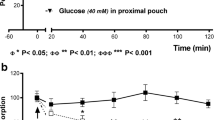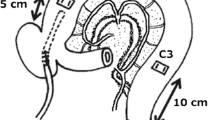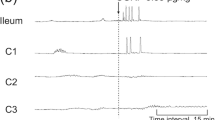Abstract
Both intrinsic and extrinsic neurons of the gut respond to mechanical and chemical stimuli by the release of neurotransmitters. We summarize here some of our recent work on the role of vasoactive intestinal polypeptide (VIP), substance P (SP) and neurokinin A (NKA) in the secretory, motor and vascular effects of hydrochloric acid stimulation in the isolated rat duodenal loop and electrical nerve stimulation and mechanical stimulation of the cat colon. Isolated duodenal loops of conscious rats were perfused with isotonic saline, and challenged at hourly intervals with brief exposures to increasing concentrations of HCL. The concentrations of bicarbonate and prostaglandin E2 (PGE2) released from the duodenal mucosa were significantly augmented already by pH 5.0 whereas VIP was significantly augmented at pH 3.0 and the tachykinins SP and NKA at pH 2.0. Continuous electric stimulation of the pelvic nerve in cats at 4 Hz during 1 s with 10 s rest produced a marked release of NKA-LI and SP-LI from the colon to blood. Reflex activation of the pelvic nervae by mechanical stimulation of the anus or rectal distension produced a less pronounced release of NKA-LI and SP-LI from the colon to blood. There was a simultaneous colonic contraction and vasodilation during each nerve stimulation. Close intraarterial infusions of NKA, neurokinin B, SP, neuropeptide K (NPK), eledoisin and physalemin at doses of 0.1–100 pmol/min induced dosedependent proximal and distal colonic contractions and vasodilation, NKA being the most potent. The effects of the tachykinins were reduced after tetrodotoxin and atropine, but unchanged after treatment with hexamethonium. Taken together, the present findings indicate that peptides present in primary afferents including VIP, SP, and NKA are involved in physiological regulatory mechanisms including smooth muscle contraction, bicarbonate secretion and vasodilation in the gut.
Access this chapter
Tax calculation will be finalised at checkout
Purchases are for personal use only
Preview
Unable to display preview. Download preview PDF.
Similar content being viewed by others
References
Aly, A., Gréen, K., and Johansson, C., 1984, Prostaglandin E2 in basal gastric secretion and during stimulation of muscarinic receptors in man, Acta Physiol. Scand., 122:583.
Brodin, E., Lindefors, N., Dalsgaard, C.J., Theodorsson-Norheim, E., and Rosell, S., 1986, Tachykinin multiplicity in rat CNS as studied using antisera raised against NKA and SP, Regulatory Peptides, 13:253.
Fahrenkrug, J., and Schaffalitzky de Muckadell, O.B., 1977, Radioimmunoassay of vasoactive intestinal polypeptide (VIP) in plasma, J. Lab. Clin. Med., 89:1379.
Ekblad, E., Winther, C., Ekman, R., Håkansson, R., and Sundler, F., 1987, Projections of peptide-containing neurons in rat small intestine, Neuroscience, 20:169.
Holzer, P., Lippe, I. Th., and Holzer-Petsche, U., 1986, Capsaicin sensitive afferent neurons involved in post-operative and irritation-induced ileus in the rat, Gastroenterology, 91:360.
Holzer, P., 1988, Local effector functions of capsaicin-sensitive sensory nerve endings: involvement of tachykinins, calcitonin gene-related peptide and other neuropeptides, Neuroscience, 24:739.
Isenberg, J.I., Wallin, B., Johansson, C., Smedfors, B., Mutt, U., Tatemoto, K., Emås, S. 1984, Secretin, VIP and PHI stimulate rat proximal duodenal surface epithelial bicarbonate secretion in vivo, Regulatory Peptides, 8:315.
Flemström, G., 1977, Active alkalinization by amphibian gastric fundic mucosa in vitro, Am. J. Physiol., 233:E1.
Martling, C.-R., Theodorsson-Norheim, E., Norheim, I., and Lundberg, J.M., 1987, Bronchoconstrictor and hypotensive effects in relation to pharmacokinetics of tachykinins in the guinea-pig — evidence for extraneuronal cleavage of Neuropeptide K to neurokinin A, Naunyn. Schmiedeberg’s Arch. Pharmacol., 336:183.
Matthews, M.R., Cuello, C., 1984, The origin and possible significance of substance P immunoreactive networks in the prevertebral ganglia and related structures in the guinea-pig, Phil. Trans. R. Soc., B306:247.
Sharkey, K.A., Williams, R.G., and Dockray, G.J., 1984, Sensory substance P innervation of the stomach and pancreas: demonstration of capsaicin-sensitive sensory neurons in the rat by combined immunohistochemistry and retrograde tracing, Gastroenterology, 87:914.
Smedfors, B., Theodorsson, E., Aly, A., Muscat, A., Pmja, A.B., and Johansson, C., 1989, HCL-induced duodenal HCO3. secretion is associated with concentration related release of local prostaglandin E2, vasoactive intestinal peptide, neurokinin A and substance P in the rat, Eur. J. Gastroenterol. Hepatol., 1:193.
Theodorsson-Norheim, E., Norheim, I., Öberg, K., Brodin, E., Lundberg, J.M., Tatemoto, K., and Lindgren, P.G., 1985, Neuropeptide K: A major tachykinin in plasma and tumour tissues from carcinoid patients, Biochem. Biophys. Res. Commun., 1131:77.
Theodorsson-Norheim, E., Hemsèn, A., Brodin, E., and Lundberg, J.M., 1987, Sample handling techniques when analyzing regulatory peptides, Life Sciences, 41:845.
Author information
Authors and Affiliations
Editor information
Editors and Affiliations
Rights and permissions
Copyright information
© 1991 Springer Science+Business Media New York
About this chapter
Cite this chapter
Theodorsson, E. et al. (1991). Aspects on the Role of Tachykinins and Vasoactive Intestinal Polypeptide in Control of Secretion, Motility and Blood Flow in the Gut. In: Costa, M., Surrenti, C., Gorini, S., Maggi, C.A., Meli, A. (eds) Sensory Nerves and Neuropeptides in Gastroenterology. Advances in Experimental Medicine and Biology, vol 298. Springer, Boston, MA. https://doi.org/10.1007/978-1-4899-0744-8_21
Download citation
DOI: https://doi.org/10.1007/978-1-4899-0744-8_21
Publisher Name: Springer, Boston, MA
Print ISBN: 978-1-4899-0746-2
Online ISBN: 978-1-4899-0744-8
eBook Packages: Springer Book Archive




